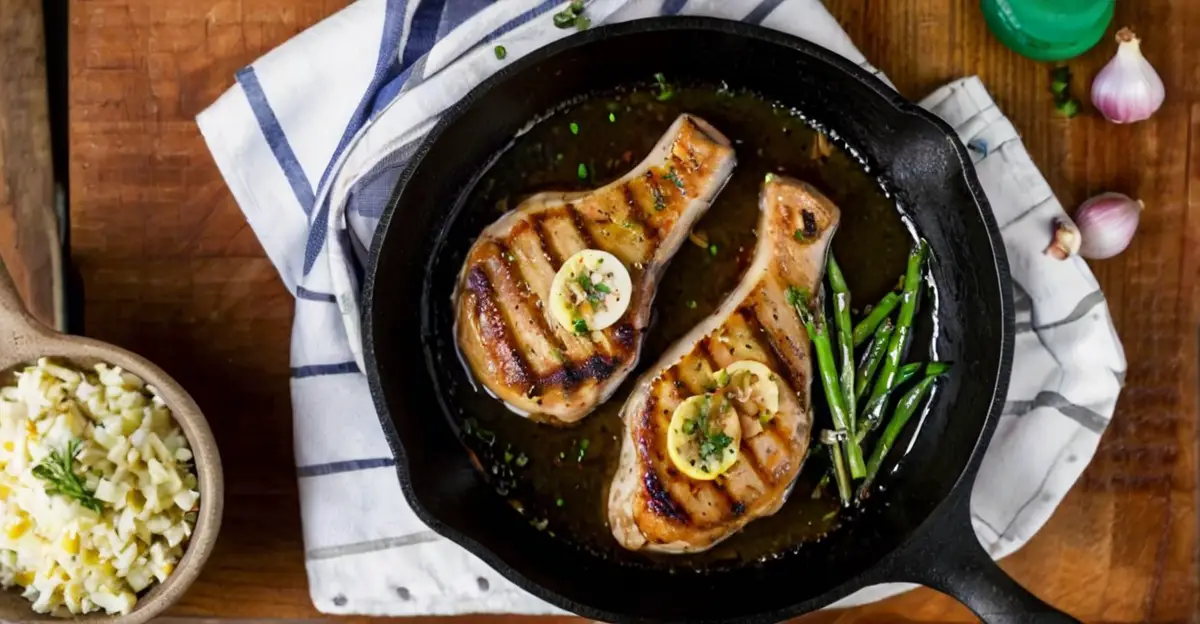Imagine creating a gourmet meal in less than 15 minutes. That’s the magic of Garlic Butter Pork Chops in a Cast Iron Skillet. This dish is not just about the juiciest and most tender pork chops; it’s a symphony of flavors. The thick, bone-in chops are Pan-seared to perfection, developing a caramelized crust that’s simply irresistible. The herb and garlic-infused butter sauce adds a depth of flavor that transforms this dish from a simple family dinner to something you’d proudly serve to impress your friends.
The key to these perfect pork chops lies in the cooking technique. Pan searing the chops in a skillet locks in the juices, ensuring every bite is tasty and flavorful. The process is simple and economical, yet the outcome rivals any slow cooker or grilled dish. The buttery garlic and herb sauce acts as a baste, keeping the meat moist and infusing it with rich flavors. This easy-to-make recipe is my favorite way to cook pork chops. Plus, it pairs beautifully with a range of side dishes, from microwave-cooked mashed potatoes to a sweet potato, making it versatile for any occasion.
As a personal touch, I love adding a bit of extra garlic to the sauce, because let’s face it, everything’s better with more garlic! The easiest part? It’s all done in one skillet, making cleanup a breeze. Remember, the secrets to avoiding overcooked, dry pork are simple: use thick chops, don’t rush the cooking process, and let the meat rest after cooking. This ensures each pork chop is as juicy and flavorful as it can be, every single time.
Why You’ll Love this Method for Pan-Seared Pork Chops
- Quick: This method for cooking pork chops is fast, turning out a delicious meal in minimal time.
- Well-Rounded Meal: Pan-searing creates a well-rounded dish, balancing taste and texture.
- Simple Ingredients: The recipe uses simple, easily available ingredients.
- Fancy Cooking, Easy Process: Despite being simple, this method makes you feel like a gourmet chef at your dinner table.
- Perfect Golden Crust: Achieve a perfectly cooked golden crust on the pork chops.
- Garlic and Herb Butter Gravy: The chops are drenched in a garlic and herb butter gravy, enhancing their taste.
- Butter Sauce: Spooning the butter sauce over the chops infuses them with rich flavors.
- Pan-Frying for Flavor: The method involves pan-frying, which is key to the dish’s deep flavor profile.
- Pork Chops as the Star: The dish highlights the natural flavors of pork.
What Cut of Pork is Best for Skillet Pork Chops
When it comes to preparing Garlic Butter Pork Chops in a Cast Iron Skillet, selecting the right cut of pork is crucial. Thick cut, bone-in pork chops are ideal for this recipe. These cuts cook more evenly, preventing the outside from getting overcooked while the inside remains tender. The bone in the chops contributes to the flavor and helps to lock in the juices, ensuring each bite is succulent.
Avoid using thin chops as they can easily become dry and overcooked. The beauty of thicker chops lies in their ability to marinate effectively in the garlic butter sauce, which imparts a rich flavor and maintains moisture. When you sear these thicker cuts in a hot skillet, you create a delectable crust on the outside while preserving the tenderness inside.
As a personal tip, always let the pork chops come to room temperature before cooking. This step ensures they cook more evenly and absorb the flavors of the garlic butter sauce better. Remember, the key to perfect skillet pork chops is not just in the cooking method but also in choosing the right cut that won’t dry out or get overcooked.
The Secret to Making Juicy Garlic Butter Pork Chops
The journey to making the most juicy garlic butter pork chops starts well before they hit the skillet. The secret? It’s all in the marination. Marinating the pork chops in buttermilk, much like you would with chicken, is crucial. This process helps to break down the proteins in the meat, tenderizing it. Ideally, they should soak overnight, but if time is short, aim for at least 2 hours.
When it’s time to cook, the focus shifts to avoiding overcooking. Overcooked pork chops are often dried out and tough, but there’s a precise point where they’re just perfect. Aim to cook them until they reach an internal temperature of 145°F. This is not just the safe serving point for pork but also the sweet spot for perfectly cooked meat.
To achieve this, use an instant-read thermometer to regularly check the meat as it gets close to being done. When the thermometer reads 135°F, remove the pork chops from the heat. This might seem early, but it’s a critical step. The pork chops will continue to cook outside the skillet due to the residual heat.
Once off the heat, let the pork chops rest on a cutting board. You can tent them with foil to keep them warm, but there’s no need to wrap them tightly. Let them sit for about 5 minutes. During this time, the temperature will come up to the perfect temperature of 145°.
The result? Perfectly cooked pork chops that are tender, juicy, and bursting with flavor, every single time.
Ingredients for Cast Iron Skillet Pork Chops
- Bone-in pork chops – Look for thick cuts of bone-in pork- 1 inch thick or more!
- Buttermilk – I like to marinate my pork in buttermilk because the acid gently tenderizes the meat.
- Garlic –Smashed not minced. MInced garlic will burn too easily.
- Fresh rosemary and thyme sprigs – This recipe is best when made with fresh herbs.
- Pantry Staples –Salt, pepper, canola oil, butter.
How To Cook Pork Chops in a Skillet
Step 1: Marinating the Pork Chops
The journey to delicious Garlic Butter Pork Chops starts with a crucial step: marinating. Place your pork chops in a mixing bowl or Ziploc bag. Pour in enough buttermilk to thoroughly coat the chops on all sides. This process helps to tenderize the meat. Seal the bag or cover the bowl and refrigerate for a minimum of 2 hours, though leaving them overnight is recommended for optimal flavor.
Step 2: Preparing for Cooking
After marination, remove the pork chops from the buttermilk, discard the marinade, and rinse the chops. Dry them thoroughly using a paper towel, patting gently. Next, season the meat on both sides with salt and black pepper. Let the seasoned pork chops sit at room temperature for about 30 minutes. This step ensures even cooking.
Step 3: Searing the Pork Chops
Heat a large skillet or cast iron pan over medium-high heat and add just enough oil to lightly coat the bottom. Once the pan is hot and the oil starts to sizzle, add the pork chops. Sear them for about one minute per side to create a golden brown crust. Remember to flip them only once for the best results.
Step 4: Cooking to Perfection
After searing, reduce the heat to medium and continue cooking, flipping occasionally. Cook until the internal temperature reaches about 120°F. This usually takes 2-4 minutes, depending on the thickness of your pork chops.
Step 5: Making the Garlic Butter Sauce
Move the pork chops to the outer edge of the pan, creating open space in the center. In that space, melt a generous amount of butter and add garlic and herbs. Let them cook together briefly, then spoon this garlic butter mixture over the chops, basting them as they finish cooking to an internal temperature of 135°F.
Step 6: Resting and Serving
Once cooked, remove the pork chops from the skillet and let them rest on a cutting board for about 5 minutes. This allows their temperature to rise to the perfect 145°F. Finally, plate the pork chops on a serving platter, pour any remaining butter sauce over the top, and serve hot.
A Few Recipe Notes
When preparing Garlic Butter Pork Chops in a Cast Iron Skillet, there are a few key notes to keep in mind for the best results. First, it’s essential to adjust the recipe if you’re cooking more than 2 chops. Ensure you use a large enough cast iron skillet or pan to accommodate all the meat without overlapping. Each piece needs its own space to sear properly, which is crucial for retaining moisture and achieving that tender texture we all love in pork chops.
Heating your skillet to the right temperature is crucial. Make sure it’s very hot before you add the chops. This high heat is key to getting a good sear, which not only imparts flavor but also locks in juices, making the pork chops exceptionally tender.
Finally, pay close attention to the internal temperature of the pork chops. The magic number here is 135º. When they reach this temperature, it’s time to remove them from the skillet. This prevents overcooking, ensuring each bite is perfectly cooked and full of flavor.
Conclusion
Mastering the art of making Garlic Butter Pork Chops in a Cast Iron Skillet is a delightful culinary adventure. The journey from selecting the right cut of pork to perfecting the sear and achieving the ideal internal temperature is both rewarding and delicious. Each step, from marinating in buttermilk to the final resting of the chops, contributes to a dish that’s not only succulent and tender but also a crowd-pleaser. Whether you’re an experienced chef or a novice in the kitchen, this recipe is a testament to the simplicity and elegance of skillet cooking, sure to become a cherished staple in your cooking repertoire.
Frequently Asked Questions
Q1. What's the best cut of pork for this recipe?
The ideal cut for Garlic Butter Pork Chops is thick-cut, bone-in pork chops. They provide a perfect balance of flavor and tenderness when cooked in a cast iron skillet.
Q2. How long should I marinate the pork chops?
For optimal flavor and tenderness, marinate the pork chops in buttermilk for at least 2 hours, though overnight marination is recommended for even better results.
Q3. Can I cook more than two pork chops at a time?
Yes, you can cook more than two pork chops at a time, but make sure to use a large skillet and avoid overlapping the chops to ensure even cooking and proper searing.
Q4. What is the correct internal temperature for pork chops?
Pork chops should be removed from the skillet once they reach an internal temperature of 135°F. They will continue to rise to the perfect temperature of 145°F while resting.
Q5. Can I substitute the buttermilk in the marination process?
While buttermilk is recommended for its tenderizing properties, you can substitute it with a mixture of milk and a tablespoon of lemon juice or vinegar as an alternative.

